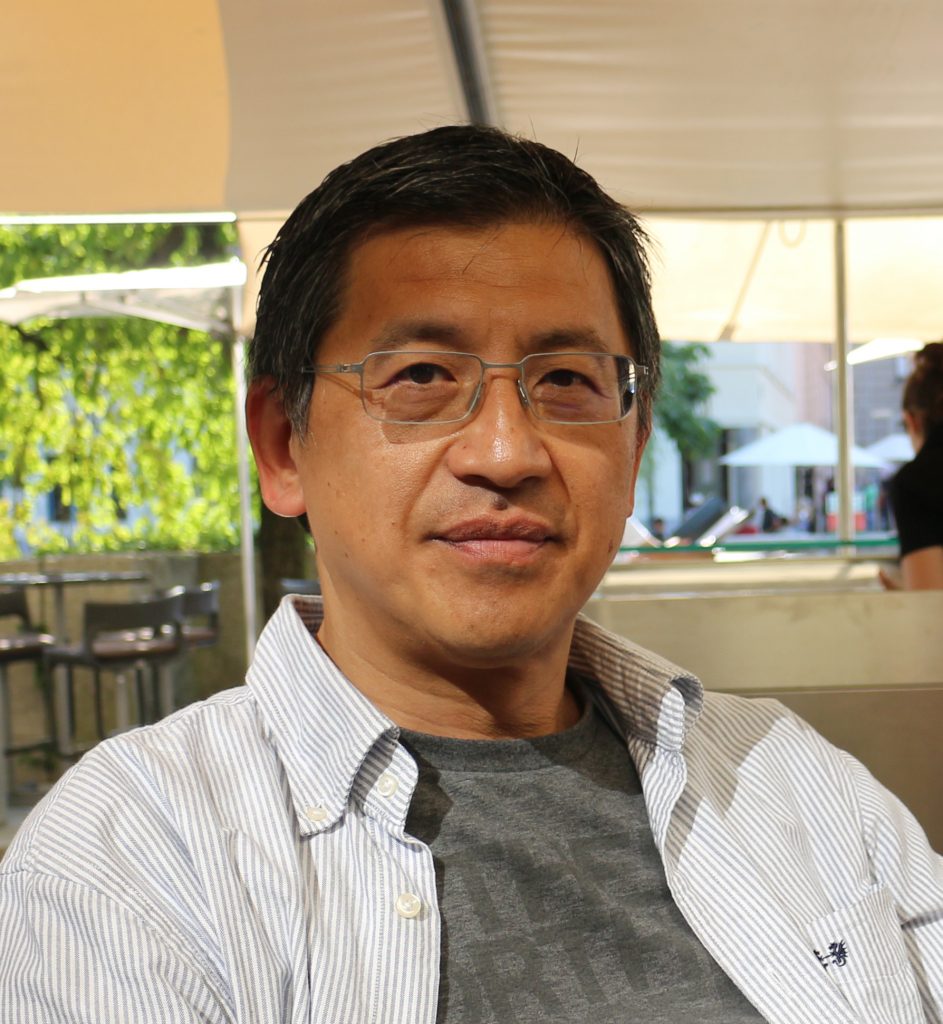Karen Schloss
Biographie

At Brown, she formed her
Visual Perception and Cognition Lab, which investigates how colors influence the way people think, feel, and behave. Her research focuses on what determines people's aesthetic preferences for colors, how those preferences influence decision making, and how colors can be used to communicate meaning in information visualizations. Karen recently moved her lab to the University of Wisconsin – Madison (Summer 2016), where she will extend her research to understand how colors influence judgments and behavior in immersive virtual environments.
Abstract: Color-Emotion Associations: Not so Hue-Based as Previously Thought
Lightness dominated their judgments (82% variance explained). Within light colors, happiness was not modulated by yellowness-blueness, but within dark saturated colors, bluer colors were actually happier than yellower colors. A follow-up experiment using colors that were perceptually matched for saturation showed the same pattern. The results imply that in the pursuit of understanding color-happiness associations, we should ask why lighter color are happier, and asking why yellower colors are happier has been the wrong question.
Almut Kelber
Biographie

Abstract: Colour Vision in dim Light
In bright sunlight, we see the world in sparkling colours, but when night falls, colours fade away until, with less than a half moon, everything appears in 50 shades of grey. The reason for this lies in our duplex retina with three types of cones - noisy photoreceptors - and only one type of rods - receptors optimized for low noise. Colour discrimination is based on comparison of cone signals, and limited by receptor noise. Over a large intensity range, the level of receptor noise stays constant, but in dim light, photon shot noise statrts impairing colour discrimination, and the absolute threshold of cone-based vision is set by dark noise in cones. Like humans, other vertebrates with duplex retinae use colour-blind rod vision in dim light.
Nocturnal insects and vertebrates lacking rods have to use the same set of receptors day and night. They have evolved adaptations to increase the sensitivity of their eyes and photoreceptors, and to reduce receptor noise. This allows them to use chromatic vision in dimmer light intensities than humans. Frogs and toads that have two types of rod use opponent signals from rods to control phototaxis even at their visual threshold, at light intensities ten times darker than the absolute threshold of human vision. However, for tasks such as prey or mate choice, their colour discrimination abilities fail at brighter light intensities, only ten times darker than the humans colour vision threshold, limited by the dark noise in their cones.
In this presentation, I review what is known about dim-light colour vision and compare colour vision thresholds with the optical sensitivity of the photoreceptors in selected animal species with lens and compound eyes.
Susanne Marschall und Achim Mittag
Biographie Prof. Dr. Susanne Marschall

Biographie Prof. Dr. Achim Mittag

Achim Mittag, geb. 1958; 1988/89 Promotion bei H. Schmidt-Glintzer in München; 1986-1994 Wissenschaftlicher Assistent; 1994-2005 Wissenschaftlicher Mitarbeiter, Lehrtätigkeit und Professurvertretung in Bielefeld, Leiden, Marburg, New York, Essen. Seit 2005 Professor für Chinesische Sprache, Literatur und Philosophie an der Universität Tübingen; Forschungsschwerpunkt: Chinesische Historiographie und historisches Denken in China. Wichtige Publikationen: Historical Truth, Historical Criticism, and Ideology. Chinese Historiography and Historical Culture from a New Comparative Perspective (Hrsg., mit H. Schmidt-Glintzer u. J. Rüsen; 2005); Conceiving the "Empire". China and Rome Compared (Hrsg., mit F.-H. Mutschler; 2008).
Abstract: Love, Passion and All-Under-Heaven: Die Ordnung der Farben in Zhang Yimous Hero
Der namenslose Held in Zhang Yimous Hero (2003) trägt Schwarz, während er dem Kaiser die Vorgeschichte eines geplanten Attentats erzählt, das von ihm schließlich doch nicht ausgeführt werden wird. Wie in dem japanischen Film Rashomon von Akira Kurosawa aus dem Jahr 1950 fächert sich diese Vorschichte in widersprüchliche Varianten auf, die allerdings anders als in dem filmhistorisch bedeutenden Vorbild nur von einem Erzähler vorgetragen werden: dem namenslosen Helden und Attentäter höchstselbst. Die einzelnen Geschichten unterscheiden sich nicht nur im Inhalt, sondern vor allem auch in den Farben der Mise en Scène, der Kostüme und des Lichts, das auf die Figuren fällt.
Zhang Yimous Hero handelt von der schillernden Wahrheit, die sich dem Zugriff des Menschen prinzipiell entzieht, und konfrontiert ein globales Publikum zugleich mit den emotionalen Wirkungen fast monochrom leuchtender Farbflächen. Die bunten Farben der einzelnen Sequenzen scheinen sich in dem schwarzen Gewand des namenlosen Helden wie in der subtraktiven Farbmischung zu überlagern, bis sie ausgelöscht sind. Viele Zuordnungen, zum Beispiel die glühend roten Inszenierungen der Eifersuchtsszenen sind international unmittelbar zu verstehen. Zugleich ist die Farbensprache des Films Hero zutiefst in der chinesischen Kultur verankert. Sie verweist auf das traditionelle Farbkonzept der Fünf Wandlungsphasen, das Bestandteil der chinesischen Philosophie des korrelativen Denkens ist. Der Vortrag nähert sich dem Thema der Farbdramaturgie und der kulturspezifischen Symbolsprache der Farben aus filmwissenschaftlicher und sinologischer Perspektive und fächert die konkurrierenden Interpretationsmöglichkeiten von Hero am Beispiel ausgewählter Szenen auf.
Prof. Dr. Robert Horres
Biographie

Zu seinen Forschungsschwerpunkten gehören Technik, Gesellschaft und Kultur in Japan. Aktuell arbeitet er an einem Projekt zur Geschichte des Holzhandwerks in Japan. Ein weiteres Projekt ist im Bereich Digital Humanities angesiedelt und befasst sich Problemen der Digitalisierung kulturellen Erbes.
Abstract: Traditionelle Farben Japans
Ausgehend von einer lexikographischen Betrachtung und einer Einführung in die Problematik historischer Farben wird eine Betrachtung des Feldes der traditionellen Farben Japans angestellt.
Dabei werden Symbolik, Verwendungskontexte und soziale Markierung der traditionellen Farbsystematik als Referenzsystem verstanden, welches in diversen modernen Kontexten der japanischen Gesellschaft bis heute wirkmächtig ist.
Einen Schwerpunkt der Ausführungen bilden die mit dem Feld traditionelle und historische Farben verbundenen methodischen und definitorischen Probleme sowie die Frage der Repräsentanz in den Neuen Medien und der heutigen Medienkultur.
Kazuhiko Yokosawa
Biographie

His research interests lie in attention, object recognition, and multi-sensory perception. Recently he is concerned with color preference and Japanese grapheme-color synesthesia.
Abstract: Ecological Effects in Cross-Cultural Differences on Single Colour Preferences: The Effect of Symbolic / Conceptual Associations
Palmer and Schloss (2010) reported that preference for a given color is largely determined by affective responses to all of the objects associated with that color. Their ecological valence theory posits that it would be adaptive for people to engage with objects whose colors they like and to avoid objects whose colors they dislike to the extent that their color preferences are correlated with objects that are beneficial/harmful to them. Palmer and Schloss developed an empirical procedure to measure the WAVEs (weighted affective valence estimates) of colors. Each color’s WAVE is the average valence (liking/disliking) rating for all object descriptions given as associations of that color, with each object-valence rating weighted by how well it matches the color for which it was described. U.S. WAVEs strongly predicted average U.S. color preferences (r = .89). For example, people generally like blues and cyans partly because they like blue and cyan objects, such as clear sky and clean water, whereas they generally dislike greenish-browns partly because they dislike greenish-brown objects, such as biological wastes and rotting food.
Color preferences are influenced by color-related experiences within one’s lifetime. Such experiences include a multitude of culturally specific experiences with ecological objects. For example, ecological factors might influence differences between U.S. and Japanese color preferences. Yokosawa, Schloss, Asano, & Palmer (in press) reported that Japanese and U.S. color preferences have both similarities (e.g., peaks around blue, troughs around dark-yellow, and preferences for saturated colors) and differences (e.g., Japanese participants like darker colors less than U.S. participants do). The ecological valence theory implies that within-culture WAVE-preference correlations should be higher than between-culture WAVE-preference correlations. The results supported these predictions. However, object-based WAVEs in Japan predict Japanese color preferences somewhat less strongly (r = .61) than object-based U.S. WAVEs predict U.S. color preferences (r = .89).
Why might object-based WAVEs explain so much less variance in Japan than in the U.S.? Following Palmer, Schloss, Guo, Wung, Chai & Peng (submitted), we hypothesized that symbolic/conceptual associations with colors may also contribute to Japanese color preferences. Symbolic WAVEs were calculated using the same procedure as for object-based WAVEs, except restricting people’s color associations to symbols and abstract concepts. The correlation between color preferences and the symbolic WAVEs in Japan (r = .57) was comparable to that between color preferences and object-based WAVEs (r = .61). Including both symbolic and object WAVEs produced a multiple-R of .72, indicating that both object and symbolic/conceptual associations with colors contribute to single color preferences in Japan. Further analyses show that symbolic WAVEs were as highly correlated with color preferences as object-based WAVEs were in Japan, but not in the U.S. (r = .58 for symbols; r = .89 for objects). Object and symbolic/conceptual associations with colors thus have comparable impact on Japanese single color preferences. This suggests that, unlike in the US where object associations have a dominant role in color preferences, object and symbolic associations contribute equally to color preferences in Japan.
Yoko Mizokami
Biographie

She received a Ph.D. in Engineering in 2002 from Ritsumeikan University, Japan. From 2002-2006 she was a postdoctoral fellow at the University of Nevada, Reno, Department of Psychology. She moved to Chiba University in 2006.
Her research interests lie in color vision, color science, and vision in natural environments. The current research topics cover the influence of lighting to object appearance, the appearance of skin color and texture, the perception of image color difference, colorfulness adaptation, and vision deficiency.
She received the Konica Minolta Imaging Science Encouragement Award, 2015, the Indow Taro Award, 2010, the Illuminating Engineering Institute of Japan, 2000 and the Optical Society of Japan Award, 1999. She is a member of International Colour Vision Society (ICVS), Vision Sciences Society, OSA, Vision Society of Japan, Color Science Association of Japan, Optical Society of Japan, and the Illuminating Engineering Institute of Japan.
Abstract: Influence of Diffusibility of Illumination on the Appearance of Colour and Surface Properties
The appearance of object surface could be largely influenced by lighting conditions such as color, direction and diffuseness. The diffuseness of illumination would change the components of specular and diffuse reflection resulting difference in the perceived quality of object surface. However, it has not been systematically analyzed how color and surface appearance of an object is influenced by the diffuseness.
We investigated how the impression of surface appearance of test samples changes under diffused light and direct light using real samples in real miniature rooms. We prepared plane gray test samples with three different levels of surface roughness and gray spheres with matt and gloss surface. A sample was placed in the center of a miniature room with either diffuse or directed light, and observer evaluated its appearance. We used a semantic differential method to examine what types of factors were influenced by the diffusibility of illumination. The result of analysis based on 20 adjective-pairs showed that glossiness and smoothness were main factors. Samples tended to appear less glossy and smother under diffused light than under direct light, and their difference was larger for a sample with rough surface.
We also examined the color appearance of several color samples under diffused light and direct light by selecting corresponding color from a Munsell color chart placed in a separate viewing box. The results of corresponding color were similar in both lighting conditions, suggesting color appearance was stable at least for samples that we tested.
Our results suggest that the appearance of surface qualities such as glossiness and smoothness are more influenced by the diffusibility of illumination than color appearance. It also implies that the surface properties of objects should be considered when examining the influence of diffusibility of illumination on surface appearance.
Kentaro Arikawa
Biographie

Abstract: How Do Butterflies See Flowers? Their Eyes and Colour Vision
Flower-visiting butterflies have color vision, including some sophisticated aspects such as color constancy and simultaneous color contrast. Unlike the trichromatic retinas of humans (blue, green and red cones (plus rods)) and honeybees (UV, blue and green cells), we have found that the compound eyes of butterflies contain six, nine or even fifteen photoreceptor classes in species-specific manner. The eyes of the Japanese yellow swallowtail, Papilio xuthus, contain six classes (UV, violet, blue, green, red and broad-band) of receptors. The six classes of receptors are embedded in small units called ommatidia, each housing nine photoreceptor cells, in three fixed combinations; the Papilio eye is a patchwork of spectrally-heterogeneous ommatidia. For example, one type of ommatidia contains the UV, blue, green and red receptors, together forming a single light-guiding rhabdom. Such organization of rhabdom well explains why Papilio butterflies can discriminate colors of dots whose size correspond to their single pixel. At the molecular level, the Papilio retina expresses five visual pigment opsins. There is therefore no one-to-one relationship between the visual pigments and photoreceptor spectral sensitivities. UV and violet receptors actually share an UV-absorbing visual pigment, while the broad-band receptors coexpress a green-absorbing and a red-absorbing visual pigments, which violates the one receptor-one opsin dogma in vision science. The six classes of receptors are embedded in small units called ommatidia, each housing nine photoreceptor cells, in three fixed combinations; the Papilio eye is a patchwork of spectrally-heterogeneous ommatidia. For example, one type of ommatidia contains the UV, blue, green and red receptors, together forming a single light-guiding rhabdom. Such organization of rhabdom well explains why Papilio butterflies can discriminate colors of dots whose size correspond to their single pixel. At the molecular level, the Papilio retina expresses five visual pigment opsins. There is therefore no one-to-one relationship between the visual pigments and photoreceptor spectral sensitivities. UV and violet receptors actually share an UV-absorbing visual pigment, while the broad-band receptors coexpress a green-absorbing and a red-absorbing visual pigments, which violates the one receptor-one opsin dogma in vision science. Do Papilio use all six for seeing colors, i.e., is Papilio hexachromatic? Trichromatic systems have their best wavelength discrimination ability in two wavelength regions. We found foraging Papilio can discriminate about 1 nm difference in three wavelength regions, which appear even better than in humans. Analysis of the behavioral data using the receptor-noise limited color opponency model indicates that the Papilio color vision is tetrachromatic based on UV, blue, green and red inputs.
Peter Hacker
Biographie

Ende 2004 verschlägt es ihn ins Schwabenland und er beginnt ein einjähriges Praktikum bei der Stuttgarter Postproduktionsfirma Unexpected GmbH. Es folgt eine Festanstellung, bei der er für den technischen Support verantwortlich ist.
Parallel zu seinem Job arbeitet er als 2D-Artist & Compositor an zahlreichen Kurzfilmprojekten mit, bevor er 2005 den österreichischen Independent-Spielfilm “Auf bösem Boden” als VFX-Supervisor betreut.
Von Oktober 2007 bis Mai 2012 studiert Peter an der Filmakademie Baden-Württemberg im Bereich Animation mit Spezialisierung auf Visual Effects, entdeckt aber nebenbei seine Leidenschaft für das Color Grading. Seit 2013 ist Peter freiberuflicher Colorist und hat schon an insgesamt mehreren Hundert Projekten aus dem Bereich Werbung, Imagefilm & Spielfilm mitgearbeitet.
Abstract: Auf dem schmalen bunten Grat zwischen Kunst und Kommerz - Digitale Farbkorrektur für Kinofilme und Werbespots
Zwischen dem "Vorher" und dem "Nachher" liegen bisweilen ganze farbliche Welten: Im Ausdruck und in der Wirksamkeit der gesamten Geschichte, sogar in der grundsätzlichen Aussage der Bilder, die Peter Hacker, von Beruf sogenannter "Digital Colorist" bearbeitet. Die Möglichkeiten sind schier unendlich und dementsprechend schwer ist es, genau den richtigen Farbton, genau den richtigen Mittelweg zu finden. Farbtheorie ist wissenschaftlich belegt, doch jeder Mensch nimmt Farben anders wahr - Peter Hacker jongliert demnach nicht nur mit Farben, sondern auch mit Vorstellungen von Kunden, Agenturen und Regisseuren - und natürlich seiner eigenen kreativen Vision.
Wie das alles unter einen Hut zu bringen ist, wo die Technik endet und Kreativität anfängt, wie man denn überhaupt fantastische Bilder aus "mäßigem" Ausgangsmaterial zaubert und am Ende alle Beteiligten glücklich macht - davon erzählt Peter Hacker anhand vieler praxisnaher und nachvollziehbarer Beispiele in seinem Vortrag.
There can be worlds bewteen"before" and "after" - worlds of colors. In expression, reception, emotion. In a story's total impact. Even the most basic message of images is steered, enhanced, or turned inside-out, by Peter Hacker, a so-called "Digital Colorist". The possibilities are endless and it takes a composer conducting light and colors to find the right notes of coloring and hit the golden mean. While the theory of colors is scientifically established, every human perceives colors differently. Therefore Peter Hacker not only juggles with colors, but also with the imagination and expectations of customers, agencies, and directors - and, of course, with his own artistic creative vision. How to balance all these factors, how technology and creativity mingle, how to conjure up fantasic images based on "mediocre" raw footage to impress all stakeholders at the end - all of this is part of Peter Hackers lecture by showcasing practical examples.
Bernd Wissinger
Biographie

Abstract: Genetics of Inherited Colorblindness in Humans
Prof. Kirsten Thompson, Ph.D.
Biographie

Kirsten Moana Thompson is Professor of Film and Director of Film Programme at Seattle University. Previously, she was Professor of Film Studies and Director of the Film Programme at Victoria University, in Wellington, New Zealand, as well as (and previously) Associate Professor and Director of the Film Program at Wayne State University in Detroit. She teaches and writes on animation and colour studies, as well as classical Hollywood cinema, German, New Zealand and Pacific studies. She is the author of Apocalyptic Dread: American Cinema at the Turn of the Millennium (SUNY Press, 2007); Crime Films: Investigating the Scene (Wallflower: 2007), and co-editor with Terri Ginsberg of Perspectives on German Cinema (GK Hall: NY, 1996). She is currently working on a new book on Colour, Visual Culture and Animation.
Abstract: Disney Animation and the Wonderful World of Colour
Disneys Animationskunst und die Wundervolle Welt der Farben
Kleine und große Filmfreunde lieben Walt Disney vor allem als Erfinder von klugen Mäusen und geizigen Enten oder aber durch herzergreifende Märchenfilme wie Schneewittchen oder Tiergeschichten wie Bambi. Vielen ist nicht bekannt, dass Walt Disney zu den treibenden Kräften bei der Entwicklung des us-amerikanischen Technicolor-Verfahrens zählte, das bis heute als bestes Farbfilmverfahren aller Zeiten gehandelt wird. Die Oppulenz und Brillianz der Technicolor-Farben inspirierten den Meister des vergnüglichen Trickfilms aber auch formal-ästhetisch zu Experimenten im Kino, aber auch auf der Bühne seiner Vergnügungsparks.
From the multiplane camera to animatronics, Disney has been always been a technological innovator but less is known about Disney's important developments in colour technology, from the Technicolour Silly Symphonies to his farsighted shift to colour television in the early sixties and the studio’s more recent innovations in theme park colour entertainment from The Fantasmic show to the Paint the Night Parade. This keynote will focus on "The Wonderful World of Colour" a nighttime entertainment spectacle that combines water, fire, laser light and colour with animation from Disney films that are projected on ephemeral water and mist screens created by hundreds of choreographed fountains. The show’s innovations in theatrical exhibition hybridise older entertainment forms with digital-controlled light and colour design and immersive effects, blending tourism, the amusement park and cinematic projection. I will examine the relationship between the transparent, translucent and opaque in the show’s ephemeral misty surfaces and related new media forms to ask: how might we understand colour animation not just as a technological medium but something which enlivens and transforms our world?